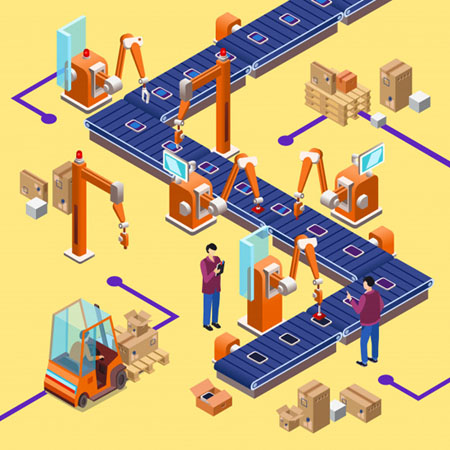Machine vision is the incorporation of computer vision into industrial manufacturing processes, although it does differ substantially from computer vision. In general, computer vision revolves around image processing. Machine vision, on the other hand, uses digital input and output to manipulate mechanical components. Devices that depend on machine vision are often found at work in product inspection, where they often use digital cameras or other forms of automated vision to perform tasks traditionally performed by a human operator. However, the way machine vision systems ‘see’ is quite different from human vision.
THE COMPONENTS OF A MACHINE VISION SYSTEM CAN VARY, BUT THERE ARE SEVERAL COMMON FACTORS FOUND IN MOST. THESE ELEMENTS INCLUDE:
- - Digital or analog cameras for acquiring images
- - A means of digitizing images, such as a camera interface
- - A processor
When these three components are combined into one device, it’s known as a smart camera. A machine vision system can consist of a smart camera with the following add-ons:
- - Input and output hardware
- - Lenses
- - Light sources, such as LED illuminators or halogen lamps
- - An image processing program
- - A sensor to detect and trigger image acquisition
- - Actuators to sort defective parts
HOW MACHINE VISION SYSTEMS WORK
Although each of these components serves its own individual function and can be found in many other systems, when working together they each have a distinct role in a machine vision system.
To understand how a machine vision system works, it may be helpful to envision it performing a typical function, such as product inspection. First, the sensor detects if a product is present. If there is indeed a product passing by the sensor, the sensor will trigger a camera to capture the image, and a light source to highlight key features. Next, a digitizing device called a framegrabber takes the camera’s image and translates it into digital output, which is then stored in computer memory so it can be manipulated and processed by software.
In order to process an image, computer software must perform several tasks. First, the image is reduced in gradation to a simple black and white format. Next, the image is analyzed by system software to identify defects and proper components based on predetermined criteria. After the image has been analyzed, the product will either pass or fail inspection based on the machine vision system’s findings.
To understand how a machine vision system works, it may be helpful to envision it performing a typical function, such as product inspection. First, the sensor detects if a product is present. If there is indeed a product passing by the sensor, the sensor will trigger a camera to capture the image, and a light source to highlight key features. Next, a digitizing device called a framegrabber takes the camera’s image and translates it into digital output, which is then stored in computer memory so it can be manipulated and processed by software.
In order to process an image, computer software must perform several tasks. First, the image is reduced in gradation to a simple black and white format. Next, the image is analyzed by system software to identify defects and proper components based on predetermined criteria. After the image has been analyzed, the product will either pass or fail inspection based on the machine vision system’s findings.
GENERAL APPLICATIONS
Beyond product inspection, machine vision systems have numerous other applications. Systems that depend on visual stock control and management, such as barcode reading, counting, and store interfaces, often use machine vision systems. Large-scale industrial product runs also employ machine vision systems to assess the products at various stages in the process and also work with automated robotic arms. Even the food and beverage industry uses machine vision systems to monitor quality. In the medical field, machine vision systems are applied in medical imaging as well as in examination procedures.
ALSO READ: FIVE MYTHS ABOUT ROBOTIC VISION SYSTEMS
TO KNOW MORE ABOUT INDUSTRIAL MACHINE VISION SYSTEM CONTACT MENZEL VISION AND ROBOTICS PVT LTD CONTACT US AT (+ 91) 22 67993158 OR EMAIL US AT INFO@MVRPL.COM
Source - WWW.THOMASNET.COM

